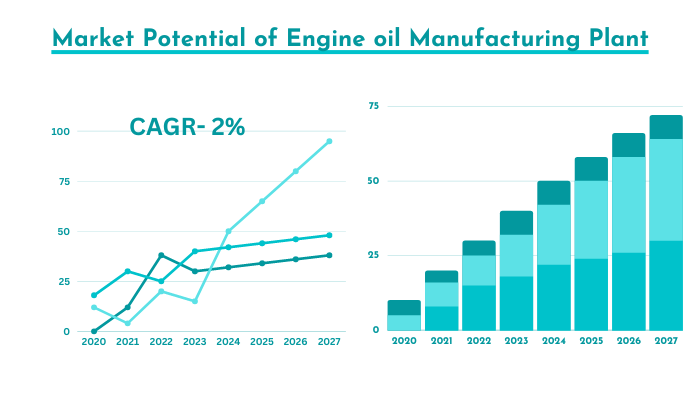Project Report For Engine Oil Manufacturing
Introduction
Engine oil manufacturing project report is as follows.
Engine oil, engine lubricants is one of the various substances used for the lubrication of internal combustion engines. Any of the various materials used to lubricate internal combustion engines are referred to as motor oil,
engine oil, or engine lubricant. They are primarily composed of basic oils that have been improved with a variety of additives, such as viscosity index improvers for multi-grade oils and anti wear additives, detergents, and dispersants. Internal combustion engines that power cars, motorbikes, lawnmowers, generators, and numerous other devices utilize motor oil as a lubricant.
Engine Oil Manufacturing Process
The manufacturing process of engine oil involves several steps, including blending, refining, and packaging. The basic ingredients of engine oil include base oils, which can be either mineral or synthetic, and additives, which are used to enhance the performance of the oil. The blending of the base oils and additives is done in a blending plant, where the ingredients are mixed in specific ratios to achieve the desired properties of the engine oil.
Refining is another important step in the manufacturing of engine oil. This process involves removing impurities and contaminants from the base oil to ensure that the oil meets the required specifications. The refining process can involve several techniques, including distillation, hydrocracking, and hydrotreating.
Once the blending and refining processes are complete, the engine oil is packaged in containers of various sizes, ranging from small bottles to large drums. The packaging is done in a clean and controlled environment to ensure that the oil remains free from contamination.

The top six businesses control a consolidated majority of the Indian lubricants market. The leading businesses are using aggressive methods and investments to maintain and grow their market dominance. About 73% of the market under study is made up of the top six competitors:
Indian Oil Corporation Ltd., HPCL, Castrol Limited, Bharat Petroleum Corporation Limited, Gulf Oil Lubricants India Ltd., and Shell India Markets Private Limited. When oil from additional sources enters the engine, dirt and other debris start to build up inside of it. If you do not replace your oil at the recommended intervals, sludge will start to build up in your engine. Regular engine oil changes and filter replacements will keep potentially harmful dirt and debris out of your engine.
Project Report Sample of
Engine Oil Manufacturing
Get Completely Custom Project Report
The increased demand from end-user industries is one of the primary reasons driving the expansion of the lubricants market in India. Construction equipment uses lubricants because of its anti-wear characteristics, corrosion resistance, and other attributes. They are used in a number of applications in the steel industry, including hydraulic fluids, compressor oils, and other substances.
Starting this kind of manufacturing company necessitates a customized business strategy based on your financial resources. If you have enough confidence, you can create your own plan. In the absence of that, you can either consult an expert or use business plan drafting software. You must pay close attention to even the smallest elements while drafting a company strategy because they will eventually benefit your brand.
Market Potential of Engine Oil Manufacturing
The engine oil market was worth over 21,000 million litres in 2021, and it is predicted to increase at a CAGR of more than 2% during the forecast period (2022-2027).
The market grew positively in 2021. Engine oils are generally used to lubricate engines that are subjected to various temperatures and pressures. Engine oils are utilized in a range of industries, including automotive, industrial, and heavy-duty equipment. According to the OICA, worldwide automotive manufacturing climbed by 9% in the first nine months of 2021 compared to the same time in 2020.
The high cost of producing and manufacturing automotive engines, on the other hand, as well as the availability of low-cost engine oil substitutes, are expected to stymie market growth. Furthermore, during the forecast period of 2022-2027, the growing societal preference for electric vehicles without engines is expected to pose a challenge to the automotive engine oil market.

This automotive engine oil market report details new recent developments, trade regulations, import-export analysis, production analysis, value chain optimization, market share, the impact of domestic and localized market players, analyses opportunities in terms of emerging revenue pockets, changes in market regulations, strategic market growth analysis, market size, category market growths, application niches and dominance, product approvals, product launches, and product launches.

